Health experts and the Centers for Disease Control and Prevention say there is more than ample evidence that universal face mask wearing can significantly reduce the spread of the coronavirus. In fact, until there is an effective vaccine with wide inoculation, short of another lockdown and quarantine, it, along with testing and tracing, may be the most effective way to bring the coronavirus infection rate in the U.S. down to a low level.
The purpose of universal mask wearing is to stop infected people from spreading Covid-19. The primary mode of Covid-19 transmission is by tiny respiratory-droplets that are projected forward from our mouths when we breathe, talk, sing, yell, cough or sneeze and then fall to the ground or on surfaces. Additionally, it is now believed that smaller infected atomized particles, aerosols, can linger suspended in the air for several hours, especially in poorly ventilated spaces.
Up until recently, the advice was to wear a mask when you can’t social distance at six feet. The logic behind the six-foot social distancing standard is that for breathing and talking in a normal voice, the droplets will fall to the floor or surfaces within six feet. That is not true for more forceful vocalization, including loud talking and singing, or coughing and sneezing, where the droplets can be projected even further.
Recent research found that the droplets can travel much further than six feet from even just talking. One current study found they could travel 9.8 feet and even up to a maximum of 26 feet for some droplets under calm air environments. Another current study found that droplets generated by coughing could travel 21 feet. A third study found that droplets from sneezing traveled 20 feet. Below is an image from that study.
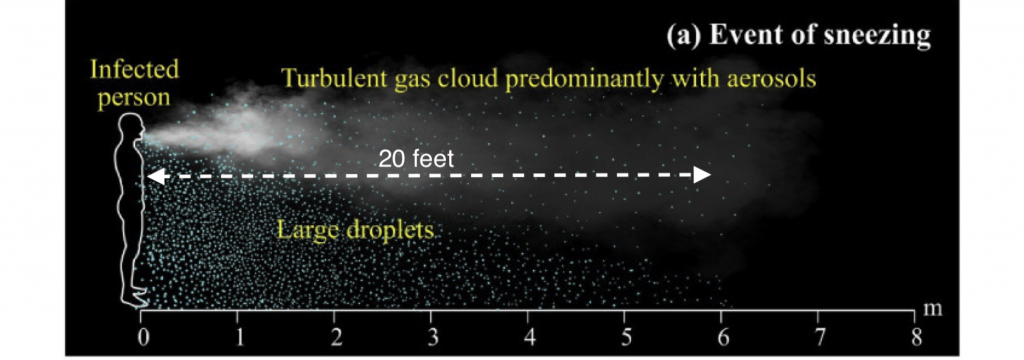
Clearly, the six-foot social distancing recommendation is totally inadequate to stop the spread of Covid-19 and may partially explain why infections surged when things opened up and mask wearing wasn’t widely being practiced.
What mask-wearing does is prevent an infected person from transmitting droplets and aerosols (and reduces the distance that any escaping ones can travel) that can then infect someone else. The degree that transmission is blocked varies depending on the type of mask.
The problem is that people with the virus who are asymptomatic and never show symptoms or are presymptomatic and will soon show symptoms are unaware they are infected with coronavirus. They are the “silent spreaders.” The CDC estimates that 40% of people infected with COVID-19 are asymptomatic.
The current confirmed U.S. infection rate is over 50,000 people a day. Recent research found that the true number of cases in the U.S. could be anywhere from 6 to 24 times higher than the confirmed number of cases. The CDC estimates the number of infections is about 10 times higher than the confirmed cases.
Most presymptomatic people are most contagious with peak viral loads for at least three days before showing symptoms. Asymptomatic people are believed to be the most contagious for at least one week.
If we conservatively assume that the true number of daily infections is only 6 times the announced number, that would mean the U.S. has 300,000 daily new infections. 60%, 180,000, would be presymptomatic and 40%, 120,000, would be asymptomatic. Here’s my rough, back-of-the-envelope calculation of how many silent spreaders there are on any one day. Assuming that presymptomatic people are infectious for only three days before they discover or suspect they are infected results in 540,000 presymptomatic people at any one time (3 x 180,000). Assuming that asymptomatic people are only infectious for one week means there are 840,000 at any one time (7 x 120,000). That works out conservatively to nearly 1.4 million pre- and asymptomatic people (1.38 million) walking around each day, unaware they are spreading the coronavirus. Using the CDC’s 10 times the reported cases computes as 2.3 million silent spreaders every day. It’s these silent spreaders who are most likely the cause of the vast majority of infections.
That’s the reason we need everyone to wear masks in public places, as the silent spreaders don’t know who they are. It could be you; it could be me; it could be that person you just talked to.
Wearing a mask can also mean getting less sick if you are infected. A hypothesis among some infectious disease experts is that face masks block, to varying degrees, some of the virus-carrying droplets and aerosols you might breathe in based on the type of mask. Therefore, you get a lower dose of the virus, or viral load, and as a result often have a less severe illness. The more viruses you get into your body, the sicker you are likely to get.
So, now it’s, “Your masks protects me and you (to a lesser degree), and my masks protects you and me (to a lesser degree).”
Mask wearing has been politicized on the principle that it violates individual freedoms. That is a pure balderdash argument. Freedoms are not unlimited in the U.S. democracy. You are free to do things so long as your action doesn’t harm other people or violate laws. You are free to go out into the public, but you are required to wear a certain level of clothing. You are not free to be nude. You are free to drive a vehicle as long as you get a license, follow the rules of the road and wear a seat belt (so you hopefully won’t injure other people and yourself in an accident). You are free to smoke as long as you don’t smoke where the smoke or secondhand smoke would harm other people. You are free to drink alcohol as long as you don’t drink over the legal driving limit as to impair your driving ability and possibly have an accident and injure or kill someone.
No one should have the freedom to infect other people with the coronavirus that can make them seriously ill, even kill them. That is exactly what a mandatory mask policy does, as the silent spreaders don’t know they are carriers of the virus. One way to think about it is that everyone right now could be a potential deadly weapon.
A number of governmental jurisdictions have enacted mandatory face mask requirements for public places, including location-based leisure venues (LBLs) such as entertainment, cultural and family entertainment centers (FECs). Should LBLs enforce those regulations in those areas? Should LBLs have mandatory mask wearing requirements for both staff and customers where their governmental jurisdiction does not? I believe they should, and to a stricter standard than the government may require; and for good reason. It is good for not only stamping out the coronavirus so the economy can grow, but selfishly good for the LBL business as it will help it grow its business back faster and protect its employees.
Here’s some of the evidence and my reasoning for that.
Some people have no fear of catching the coronavirus or think they are immune. But they are in the minority. The vast majority of people fear they will get infected and could infect their loved ones. A late July poll found that more than three-quarters of U.S. adults (77%) are worried they or someone they know will get infected from the coronavirus.

The August 6-10 Monmouth poll found that more than two-thirds of adults (69%) are worried that someone in their family will become seriously ill from the coronavirus.

The August 7-10 Axios-Ipsos poll found that 1 in 5 adults (21%) personally know someone who died from the coronavirus. The August 7-9 Harris poll found that more than half of adults (56%) fear they could die as a result of contracting the coronavirus.
The majority of people are afraid of catching Covid-19 if they visit public places. There is currently a widespread fear of going out (FOGO). That’s why for the LBLs that are open, attendance is so low. People are wary of their health if they attend. For example, the July 22-23 ABC News poll found that only 3 in 10 previous bowlers (31%) were currently willing to go bowling again.

The August 4-7 Morning Consult poll found that only 30% of adults are comfortable going to a shopping mall, only 24% to a museum, and only 17% to an amusement park.
Most people are making the decision of whether to visit an LBL, and which one to visit, based on their perceived risk of catching the coronavirus. People are becoming educated about silent spreaders, that their risk is much higher if other people around them are not wearing masks. Polls are showing this level of knowledge and concern.
Ipsos’ Consumer Health & Safety Index that evaluates how retailers are operating amid the Covid-19 pandemic found more than 6 in 10 shoppers (62%) would stop shopping at a retailer that is not taking health and safety seriously. The study found that certain practices were more critical than others, including people wearing face coverings.
A YouGov poll asked people whether they would rather shop in a supermarket that ensures all people wear masks or allows people to shop without masks. Over three-quarters (77%) prefer supermarkets where everyone wears a mask, and that included more than 6 in 10 Republicans (62%).
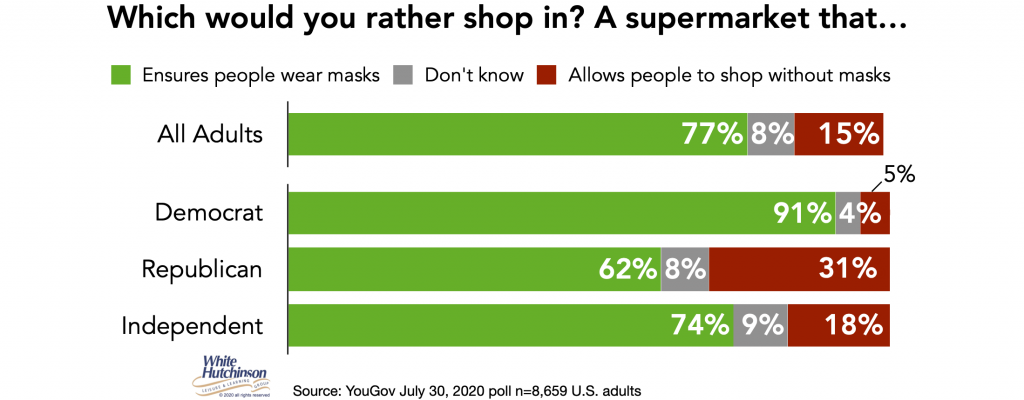
A survey by the Federal Reserve Bank of Cleveland found that two-thirds of shoppers feel more comfortable shopping in stores where employees and other shoppers are wearing masks.
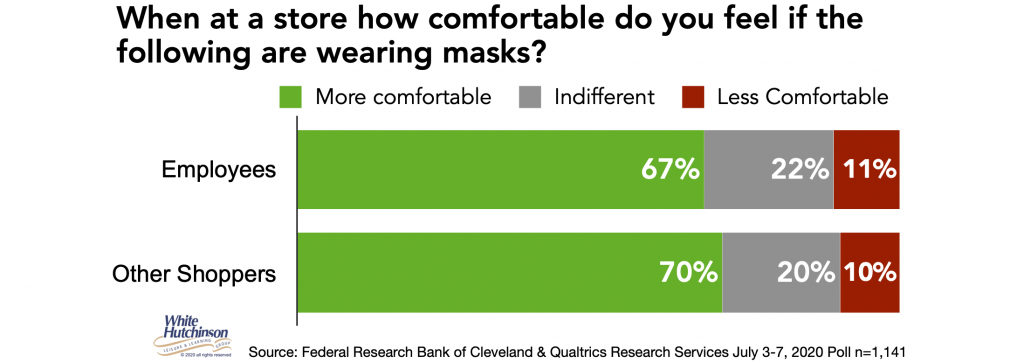
Colleen Dilenschneider, who does extensive research on visitor behavior and visit intentions for cultural organizations in the United States, found in a late July survey that over three-quarters of people (76%) said a mandatory face mask policy would make them comfortable attending different culture events, more so than a coronavirus vaccine
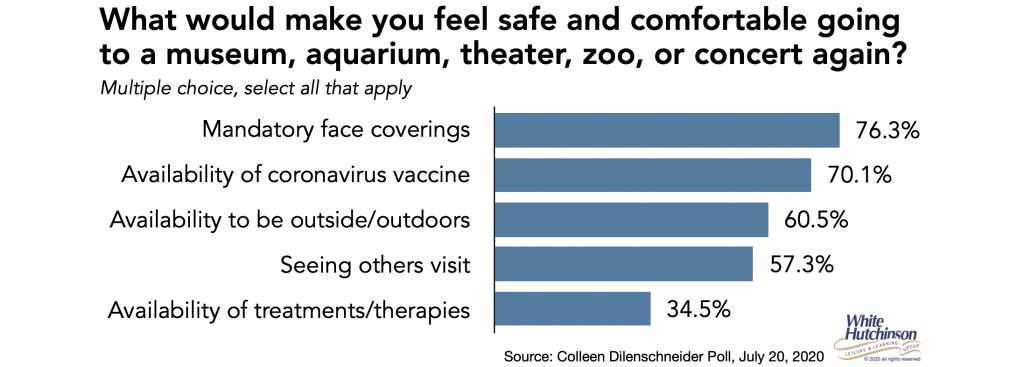
The public largely agrees that wearing face masks in public places should be mandatory. An AP-NORC poll found that three-quarters of adults favor such a policy. That include nearly 6 in 10 Republicans (58%).
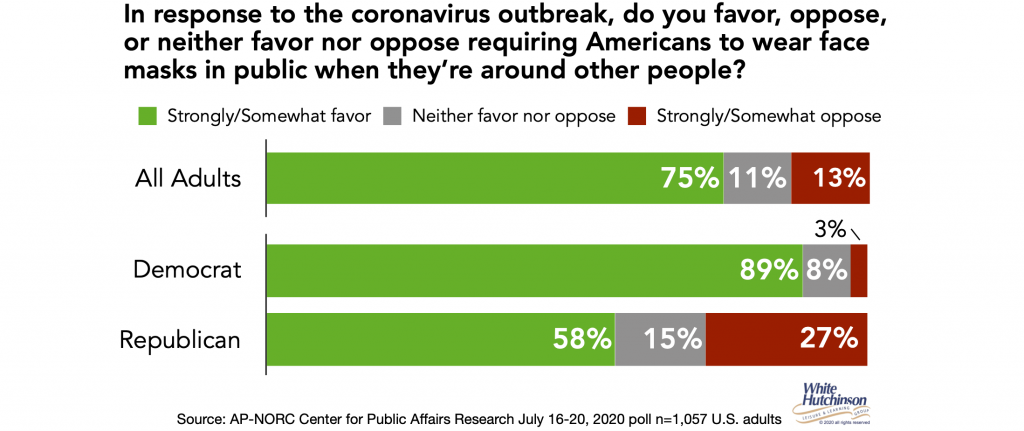
A Harvard CAPS-Harris poll found that nearly 8 in 10 registered voters (79%) support a national mandatory face mask mandate. That included two-thirds of Republicans (67%).
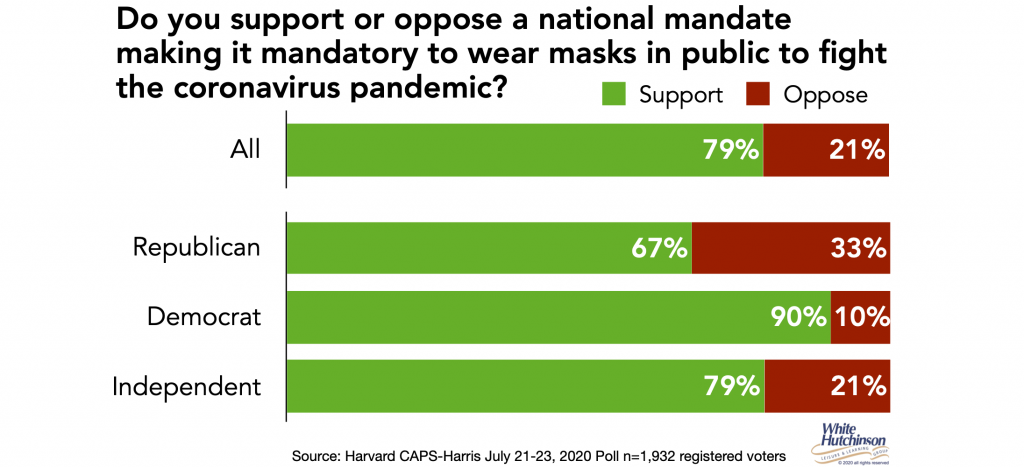
That same poll found that 7 in 10 voters support imposing fees on anyone who does not wear a mask in public places. The majority of Republicans (57%) support a fee.
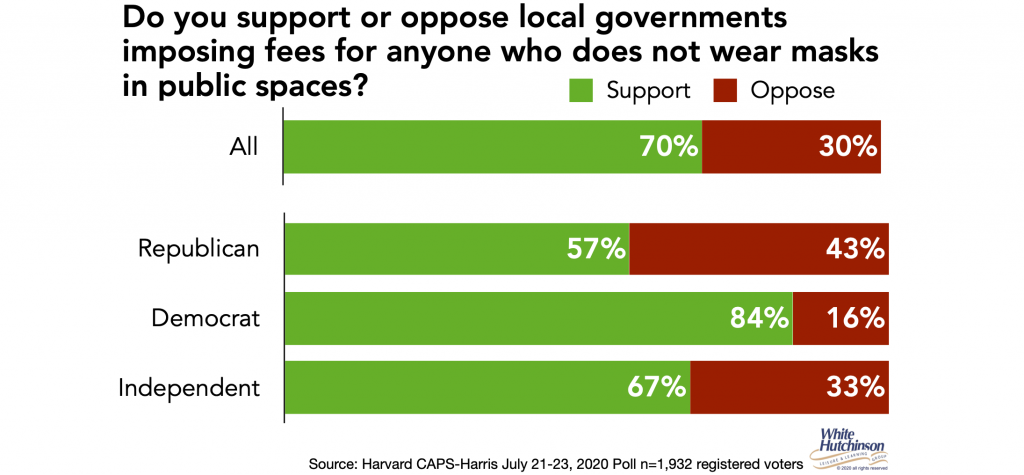
The August 7-9 Harris poll found that more than one-third of adults (37%) support fining people $100 for not wearing a mask in public for the first time. One-quarter (24%) support a $400 fine for the first offense. Nearly half (49%) said it would be justified to close businesses if they are not following proper safety precautions (e.g., enforcing masks, proper sanitation, social distancing).
I’m seeing lots of LBLs and other businesses that say they require face masks, but don’t really enforce the policy. Others only recommend them or have no policy. If you want your attendance to grow the fastest, you need to have a strict mandatory face mask policy. Yes, that small minority of people who won’t wear a mask won’t show up. But you will gain the greatest share of the vast majority of potential attendees, especially the majority of people who are most hesitant to attend if they don’t feel the LBL is really safe. One person walking around without a mask sends the message the business is not a safe place to be.
By strict, I mean no exceptions (other than age 2 or younger). That includes no medical exemptions. ADA allows restrictions to stand if an individual poses a “direct threat to the health or safety of others.” In March, the Equal Employment Opportunity Commission determined the Covid-19 pandemic met that threshold. Anyone not wearing a mask is a potential silent spreader. That is the policy most airlines are following, no medical exemptions.
There are some types of masks that are not protective and should not be allowed. An August 7, 2020 study examined the efficacy of 14 different types of masks to reduce the transmission of respiratory droplets during regular speech.
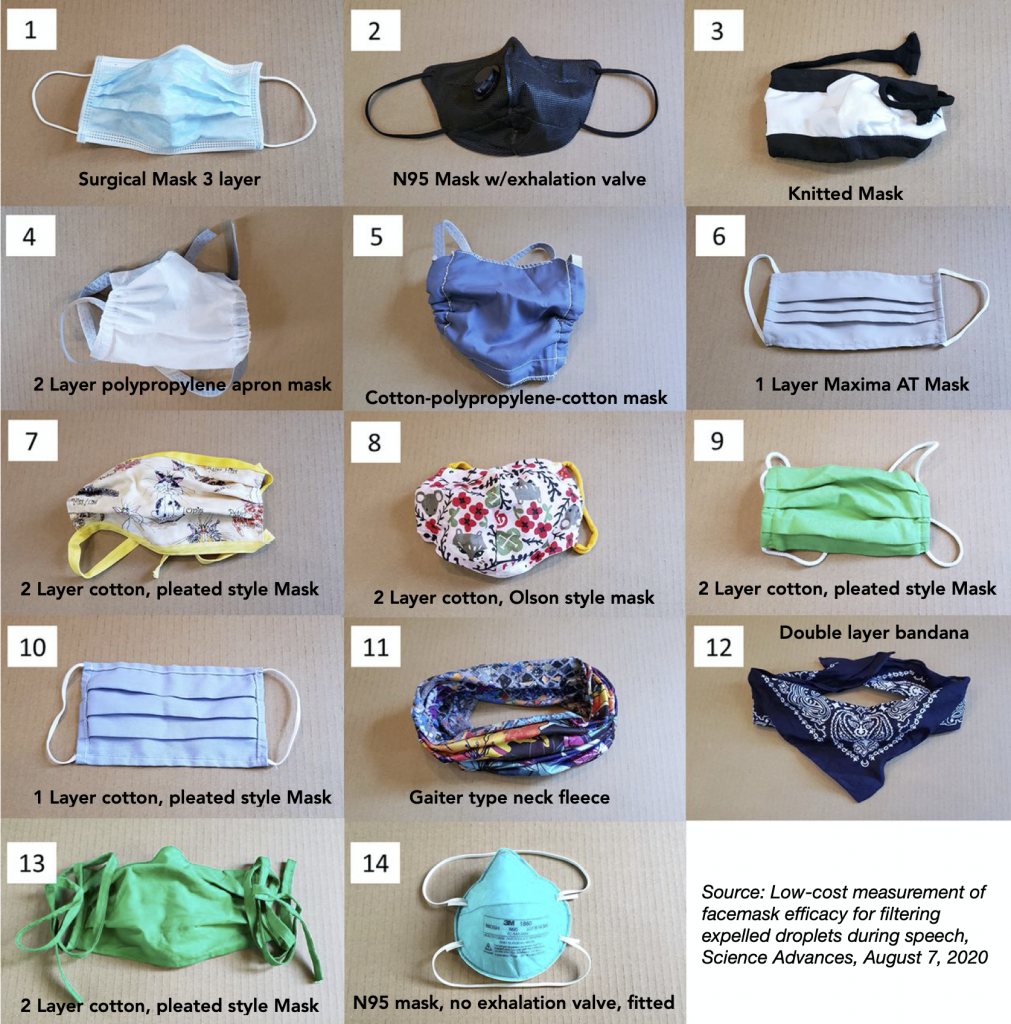
The study found that masks with exhalation valves or vents, a type of face covering made for hot and dusty construction work (N95 valve masks) are not effective in stopping the transmission of droplets. Masks with valves or vents allow air to be exhaled, allowing expelled respiratory droplets to reach others. Masks with valves have been banned by the major U.S. airlines and San Francisco. The CDC has come out with a warning about this type of mask.
The study also found that the newly popular gaiter type neck fleece masks, which are made of thin, stretchy material, are not effective. It found those type face coverings are actually worse than not wearing a mask at all, because they break up larger airborne particles into a spray of little ones, aerosols, that can linger longer in the air. It also found that double-layer cotton triangle bandanas were ineffective, probably as they are open at the bottom.

Other types of masks that should not be allowed include ones made with mesh or lace, or ones that cannot be secured under the chin. All masks need to cover the mouth and nose. Face shields are not an acceptable substitute for a mask but are a good second measure as they help protect the eyes and exposed areas of the face from droplets. The CDC does not recommend use of face shields as a substitute for masks.
Disney World’s face mask policy is, “All face coverings (whether disposable or reusable) must be made with at least two layers of breathable fabric, fully cover the nose and mouth, secure underneath the chin, fit snugly but comfortably against the side of the face, be secured with ear loops or ties and allow the guest to remain hands-free.”
Masks should be worn at all times except when eating or drinking. To avoid people trying to circumvent a mask wearing requirement by walking around with food or drink, food or drink should only be allowed to be consumed when seated.
A key consideration of growing an LBL’s business during corona-time is quite simple. To gain back the maximum number of customers, LBLs need to be perceived as safe as possible. Indoor LBLs are rated as some of the highest risk public environments. If mask wearing is not mandatory and enforced as part of safety measures, LBLs will be unattractive to the majority of potential customers, as knowing there are non-mask wearers will keep them away. The share of customers an LBL will gain with a strict, mandatory and enforced mask policy will far exceed the few non-mask wearers who will refuse to come on some principle. Remember, people always have the choice of just staying home with their many digital and virtual social, entertainment and cultural options with 100% safety, which most are currently doing.
Addendum: Since posting this blog, USA Today has published a ranking of 15 different masks of how well they might protect wearers and those around them from Covid-19. Check it out by clicking here.
Follow me on Twitter and Linkedin – I try to post news and information that is relevant to the location-based leisure, LBE and FEC industries a few times every weekday.



